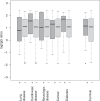Infection fatality rate of SARS-CoV2 in a super-spreading event in Germany
- PMID: 33203887
- PMCID: PMC7672059
- DOI: 10.1038/s41467-020-19509-y
Infection fatality rate of SARS-CoV2 in a super-spreading event in Germany
Abstract
A SARS-CoV2 super-spreading event occurred during carnival in a small town in Germany. Due to the rapidly imposed lockdown and its relatively closed community, this town was seen as an ideal model to investigate the infection fatality rate (IFR). Here, a 7-day seroepidemiological observational study was performed to collect information and biomaterials from a random, household-based study population. The number of infections was determined by IgG analyses and PCR testing. We found that of the 919 individuals with evaluable infection status, 15.5% (95% CI:[12.3%; 19.0%]) were infected. This is a fivefold higher rate than the reported cases for this community (3.1%). 22.2% of all infected individuals were asymptomatic. The estimated IFR was 0.36% (95% CI:[0.29%; 0.45%]) for the community and 0.35% [0.28%; 0.45%] when age-standardized to the population of the community. Participation in carnival increased both infection rate (21.3% versus 9.5%, p < 0.001) and number of symptoms (estimated relative mean increase 1.6, p = 0.007). While the infection rate here is not representative for Germany, the IFR is useful to estimate the consequences of the pandemic in places with similar healthcare systems and population characteristics. Whether the super-spreading event not only increases the infection rate but also affects the IFR requires further investigation.
Conflict of interest statement
The authors declare no competing interests.
Figures








References
-
- World Health Organization. Coronavirus (COVID-19) Dashboard. WHO, https://covid19.who.int/ (2020).
-
- The Centre for Evidence-Based Medicine. Global Covid-19 Case Fatality Rates. CEBM, https://www.cebm.net/covid-19/global-covid-19-case-fatality-rates/ (2020).
Publication types
MeSH terms
Substances
LinkOut - more resources
Full Text Sources
Other Literature Sources
Medical
Miscellaneous

